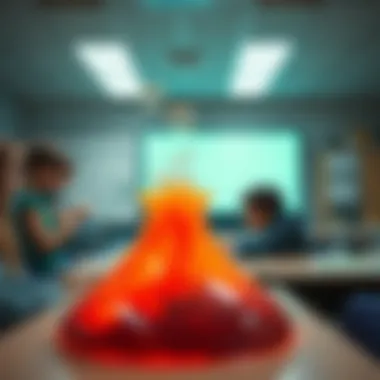Exploring Volcano Bubble Machines: Function and Use


Intro
Volcano bubble machines, while they might bring to mind childhood memories of playful science fairs or art installations, offer a rich tapestry of scientific exploration. They don’t simply create mesmerizing visuals; they embody principles steeped in fluid dynamics and gas behavior. These machines simulate volcanic activity, showcasing how gases and liquids interact under specific conditions. In essence, volcano bubble machines serve a dual purpose—they are both educational tools and artistic expressions, encouraging curiosity and creativity among makers and observers alike.
These devices present a striking illusion of lava bursting forth, infinitely captivating and informative. The mechanics behind these machines can be complex, involving various components and scientific laws. By peeling back the layers, one gains a more profound appreciation not only of the mechanics but also of their application in educational and artistic environments. From classrooms to galleries, these machines bridge the gap between solid scientific principles and the creative arts, offering a vivid demonstration of how physics can be both practical and imaginative.
As we delve deeper into the workings and the applications of these intriguing devices, we recognize the underlying principles that govern their function. Understanding these concepts will enrich our appreciation of volcanic activities in nature and enhance our approach to teaching and exploring science in engaging ways.
Let’s embark on this exploration, starting with a solid foundation in the research background.
Preamble to Volcano Bubble Machines
The domain of volcano bubble machines sits at the juxtaposition of science and art, capturing imaginations and sparking curiosity. These fascinating devices create not just fun bubble displays but also serve as dynamic tools bridging educational gaps in earth science and physics. Understanding how these machines work and their applications can greatly enhance learning experiences and foster interest in these subjects.
In discussions surrounding volcano bubble machines, several focal points emerge. Primarily, these devices exemplify complex scientific principles in a digestible form. By bringing together concepts of fluid dynamics, gas-liquid interactions, and creative design, volcano bubble machines can illustrate the dynamics of volcanic eruptions without requiring a standard laboratory. They allow students and educators alike to observe, analyze, and appreciate the science behind volcanic activity in a safer, more manageable environment. Moreover, these machines astound audiences with their whimsical displays, marrying creativity with education.
Definition and Overview
Simply put, a volcano bubble machine is a contraption that simulates volcanic eruptions by producing bubbles. When the machine operates, it releases a mixture of soap and water into an environment that introduces gas, typically air or CO2. This process creates bubbles that rise up in a manner reminiscent of lava flows. Unlike traditional soap bubble makers, the structures of these machines often include features that mimic geological formations, thereby enhancing realism.
The mechanism involves a nozzle system that allows the controlled release of air through the liquid mix, facilitating the bubble formation. The visuals produced can be an exhilarating sight, as they replicate natural phenomena, leading to a deeper appreciation for the science behind geothermal activities.
Historical Context
The concept of simulating volcanic activity can be traced back to early educational tools that aimed to demystify earth science for students. While simplistic in approach, they laid the groundwork for more sophisticated devices like the volcano bubble machine.
In the late 19th century, practical demonstrations in classrooms often relied on rudimentary models to illustrate geological concepts. As science education evolved, so did the tools available for teaching.
Volcano bubble machines began to gain traction in the early 2000s, driven by an increased interest in STEM education among educators and institutions. The rise of interactive learning environments prompted the integration of these machines in labs, museums, and schools, which significantly broadened their reach. Today, they are emblematic of hands-on learning, representing a blend of artistic expression and scientific education.
Scientific Principles at Play
Understanding the scientific principles behind volcano bubble machines is crucial for appreciating their role both in educational contexts and artistic endeavors. These machines are not just playful devices; they represent a myriad of scientific phenomena, primarily pivoted around fluid dynamics, gas behaviors, and the intricate dance of surface tension. As a result, grasping these concepts can illuminate how volcano bubble machines operate and why they serve as effective educational tools.
Basic Fluid Dynamics
Fluid dynamics is a branch of physics that studies the movement of liquids and gases. In the context of volcano bubble machines, it is essential to comprehend how fluids interact and create the spectacular visuals one might associate with a volcanic eruption.
When the bubble machine sends air through a liquid soap mixture, it creates bubbles. These bubbles form and rise because of buoyancy, which is the upward force exerted by the liquid. The interplay of pressure, velocity, and flow is where the excitement begins!
For example, the design of a nozzle can significantly influence the size and frequency of the bubbles formed. A fine nozzle creates smaller bubbles, which rise more slowly than larger ones, resulting in a mesmerizing bubble curtain that mimics volcanic gases. Various factors such as gradient changes and speed of air being pumped contribute to how the fluid effectively moves, illustrating core principles in fluid dynamics.
Gas-Liquid Interactions
Gas-liquid interactions are vital for comprehending how volcano bubble machines generate those intriguing effects. The process begins with gas, usually air, being introduced into a liquid, triggering a series of fascinating reactions.
As air is forced through the liquid soap mixture, tiny gas pockets form—this is where the magic happens. During this interaction, the surface of the bubble is an interesting frontier. It showcases a tension between the gas inside and the liquid surrounding it, creating a temporary yet fragile structure. The pressure applied to blow bubbles and the liquid's viscosity both play a role in how these interactions unfold.
In practical applications, educators can demonstrate these interactions using simple experiments with different liquids and gases. Different soap solutions can yield various bubble properties, thereby reinforcing the scientific concept that slightly adjusting variables can lead to wildly different outcomes.
Surface Tension Effects
Surface tension is a crucial aspect of how bubbles behave. This phenomenon occurs because of cohesive forces between liquid molecules, which cause the surface of the liquid to behave like a stretched elastic sheet. In the world of volcano bubble machines, this property holds the key to maintaining bubble integrity while they rise and eventually burst.
Imagine a balloon floating effortlessly in the air; it is similar to how bubbles float due to surface tension. However, once the surface tension is compromised—perhaps due to the mixture's alteration or external interference—the bubble pops, releasing a cascade of liquid back down, illustrating the ephemeral nature of volcanic activity.
In a learning environment, experiments can be crafted to observe how varying the soap concentration or liquid thickness impacts bubble size and lifespan. Understanding this fundamental property helps reinforce the broader concepts of physics in a tangible manner.


"Surface tension is what allows a bubble to form, and what ultimately determines how long it lasts—a tangible manifestation of molecular interactions."
Additional resources:
- National Geographic on Fluid Dynamics
- American Physical Society
- Honeycomb Bubbles - Understanding Bubble Science
- British Association for the Advancement of Science
- Fluid Dynamics and Applications
Components of Volcano Bubble Machines
Understanding the components of volcano bubble machines is essential for grasping how these devices operate and achieve their whimsical effect. At first glance, the complexity of these machines may seem daunting. However, breaking it down into its fundamental elements highlights not only their intricacies but also their practical applications across various fields.
Construction Materials
The materials used in the construction of volcano bubble machines play a pivotal role in their functionality and durability. Generally, these devices are composed of several key materials:
- Plastic: Most volcano bubble machines employ a plastic body as this material is lightweight yet strong. It can easily withstand wear and tear, making it ideal for both educational and recreational settings.
- Rubber: This is often used for seals and gaskets. Rubber provides flexibility and resistance to different substances, which is essential when considering safety in mechanical operations.
- Metal Components: For critical components like gears and motors, metals like aluminum or stainless steel are preferred due to their strength and heat resistance.
- Silicone: For bubble-making attachments and nozzles, silicone is often used. Its smooth surface allows air to flow through with minimal friction, ensuring efficient bubble formation.
The right balance of these materials not only affects the machine's performance but also its longevity and maintenance requirements. Choosing high-quality materials is crucial, especially in educational environments where machines are used frequently.
Mechanisms of Operation
The operation of a volcano bubble machine hinges on several interrelated mechanisms that work in harmony to create the stunning visual effects. Here's how it generally unfolds:
- Air Pumping Mechanism: This is the heart of the operation. An electric or battery-powered air pump sends air into the machine, creating pressure. This is essential for pushing air out through the bubble-making holes.
- Bubble Solution Reservoir: A dedicated chamber holds the bubble solution, typically a mixture of water and biodegradable soap. This solution is drawn into the bubble attachments, where it is saturated for optimal bubble production.
- Heat Generation: Some advanced models incorporate heat elements, mimicking volcanic eruptions. The heating system vaporizes the liquid, creating a steamy eruption effect that enhances the realism of volcanic activity.
- Bubble Ejection: As air flows through the bubble-producing nozzles, it forms bubbles. The unique shape of these nozzles helps in the creation of larger bubbles that can rise and burst in an aesthetically pleasing manner.
Each component must operate seamlessly for the volcano bubble machine to deliver its visual spectacle effectively. A failure in any part can result in poor performance, emphasizing the importance of quality design and construction.
Safety Features
As with any mechanical device that operates with pressure and liquids, safety features are crucial. Volcano bubble machines are designed with several safety considerations to protect users, particularly in educational environments. Here are some vital safety features:
- Auto Shut-off Mechanism: Many designs integrate an automatic shut-off in case of overheating or malfunction. This prevents long-term damage and reduces fire hazards.
- Non-toxic Materials: Since these machines are often used by children in educational settings, manufacturers usually ensure that all components are made from non-toxic materials, adhering to safety regulations.
- Stable Base Design: A fundamental safety feature involves the physical design of the machine. A wider base prevents the machine from tipping over, which is particularly important when liquid is involved.
- Emergency Stop Button: Some models include a manual stop feature, enabling users to halt operation instantly should any issues arise.
Understanding these components not only enhances the appreciation of volcano bubble machines but also helps in evaluating their efficacy as educational tools or artistic expressions. Overall, the design combines functionality with a whimsical charm, making it an exceptional tool across multiple disciplines.
Applications in Education
When discussing the myriad uses of volcano bubble machines, one cannot overlook their significant role in educational settings. These devices not only captivate the imagination but also serve as potent tools for teaching complex scientific principles. By engaging students’ senses, they effectively bridge the gap between theoretical concepts and tangible experimentation. This tactile learning experience can enhance comprehension, making abstract ideas more accessible and relatable.
Demonstrating Geological Processes
Volcano bubble machines offer a striking visual representation of geological processes, particularly those related to volcanism. When educators use these machines, students observe the bubbling and bursting of bubbles, simulating real volcanic activity. Each eruption, albeit harmless, provides a snapshot of how gases, pressure, and temperature variations can lead to significant geological events.
Here’s how volcano bubble machines can illustrate key geological concepts:
- Formation of Bubbles: At the heart of a volcanic eruption is the formation of gas bubbles. In a controlled environment, students see how dissolved gases come to the surface. This helps them understand concepts like gas solubility and over-saturation in magma.
- Explosive vs. Effusive Eruptions: By adjusting the settings or the materials used in the machine, different types of eruptions can be simulated. Students can compare scenarios, helping them grasp the differences between explosive eruptions, which are characterized by violent outbursts, and effusive ones, where lava flows steadily.
- Plate Tectonics: Incorporating volcano bubble machines into lessons about plate tectonics emphasizes the connection between Earth’s structure and volcanic activity. Students can visually appreciate how tectonic movements contribute to volcanic formations and eruptions.
By using these machines as hands-on demonstrations, educators motivate learners to ask questions, think critically, and connect the dots in geology.
Engagement in STEM Learning
In today’s educational landscape, fostering interest in Science, Technology, Engineering, and Mathematics (STEM) is crucial. Volcano bubble machines accomplish this by engaging students in interactive and creative ways. They not only provide insight into geological phenomena but also promote scientific inquiry and problem-solving skills.
- Inquiry-Based Learning: Students are naturally curious. As they use volcano bubble machines, they can formulate hypotheses about what will happen under various conditions. This inquiry-based approach allows them to conduct experiments, observe outcomes, and refine their understanding based on evidence.
- Cross-Disciplinary Connections: The dynamic nature of volcano bubble machines invites integration across subjects. For instance, while studying them, students can explore not just geology but also physics (understanding fluid dynamics), chemistry (gas interactions), and even art (creating visually appealing designs). This cross-pollination of subjects encourages a more holistic view of knowledge.
- Encouraging Teamwork: Setting up and operating these machines can be a collaborative experience. Group projects involving volcano bubble machines enable students to work together, share ideas, and develop teamwork skills that are invaluable in both academic and professional settings.
In summary, volcano bubble machines are more than just entertaining devices. Their applications in education highlight how they can serve as effective teaching tools that enhance students’ understanding of geology while simultaneously fostering important skills necessary for success in STEM fields.
"Education is not the filling of a pail, but the lighting of a fire." - W.B. Yeats


By igniting curiosity and stimulating interest, these machines provide a unique platform for inspiring the next generation of scientists, engineers, and innovators.
For further reading on educational techniques in geosciences, consider visiting US Geological Survey or National Science Teachers Association.
Artistic and Creative Uses
The role of artistic and creative uses of volcano bubble machines extends beyond mere entertainment. These devices serve as a bridge between scientific understanding and artistic expression, showcasing how technology can enhance creativity and vice versa. Their visually striking nature not only captivates audiences but also provides a medium for exploring complex concepts in a digestible form. At the intersection of science and art, the potential for innovation becomes boundless.
Designing Interactive Installations
In designing interactive installations, volcano bubble machines can create immersive environments that engage multiple senses. When artists integrate these machines into exhibitions, they help illustrate natural processes in a hands-on manner. Visitors can experience the bubbling and frothing of "lava" in real time, allowing for a deeper appreciation of volcanic activity. This interactive aspect serves as a powerful educational tool, encouraging participants to ask questions about the underlying scientific principles at play.
Consider the setup of a gallery featuring volcano bubble machines, where participants are invited to adjust parameters such as air pressure or liquid viscosity. This hands-on engagement not only makes learning enjoyable but also sparks curiosity about physics and geology. Through this interaction, challenges and delights are uncovered as learners transform from passive observers to active participants.
"Art is a lie that enables us to realize the truth." - Pablo Picasso
In this way, designing installations that incorporate these machines serves a dual purpose: to entertain and to educate. The visual spectacle combined with tactile interaction creates memorable experiences that resonate far beyond the exhibit.
Integrating Science and Art
The integration of science and art presents a unique opportunity to foster creativity while promoting scientific literacy. Volcano bubble machines, with their compelling visuals, illustrate scientific principles in an engaging manner. Artists can embrace the sciences, using these machines to reflect and comment on themes such as natural disasters and environmental change.
For example, an art piece could depict the transient beauty of a volcanic eruption using a volcano bubble machine. The bubbles might symbolize both the explosive force of nature and the fragility of ecosystems in landscapes shaped by such power. It conveys a message: while volcanic eruptions can be destructive, they also create new habitats and inspire artistic expression.
Furthermore, schools and educational institutions are increasingly recognizing the value in blending disciplines. By encouraging students to explore projects that fuse art and science, educators equip future generations with the tools to think creatively and solve problems. Here, volcano bubble machines can serve as a tangible example of how to integrate various domains, enhancing the learning process.
Environmental Considerations
The intersection of technology and ecology is crucial in today's world, particularly in creations like volcano bubble machines. This section emphasizes the necessity of considering environmental impacts while enjoying these engaging devices for both educational and artistic purposes. Understanding how these machines can either positively or negatively influence the environment is paramount for their sustainable use and development.
Impact on Ecosystems
Volcano bubble machines, by their very nature, draw inspiration from volcanic processes. When used in interactive displays, educational environments, or artistic installations, they mimic natural phenomena. However, it’s essential to examine their chemical and physical interactions with the surrounding environment.
- Water Usage: These machines typically utilize water in their operation. If vast water resources are drawn from local ecosystems, it could lead to habitat degradation. Using collected rainwater or recycled water in these machines can mitigate this impact substantially.
- Chemical Composition: Sometimes, the materials used in the bubble mixture can be concerning. Some soap solutions may contain chemicals that could be harmful to local wildlife if spilled or improperly disposed of. Advocating for non-toxic, biodegradable materials is crucial in ensuring that the ecosystems surrounding these machines remain unharmed.
“Environmental stewardship is not just an obligation; it’s an opportunity for innovation.”
- Wildlife Interaction: At events or installations featuring volcano bubble machines, there’s always the risk of local fauna getting curious. Bubbles might attract birds or insects, which could either be a delightful sight or a potential hazard if they get caught in machinery or impacted by any chemicals.
Implementing careful planning and precautions can turn the narrative around the interaction of bubble machines with ecosystems into a positive exchange. Through such machines, we can teach attendees about local ecosystems while also engaging in conservation efforts.
Sustainable Practices in Production
The production of volcano bubble machines can certainly be mindful of ecological footprints. Implementing sustainable practices can not only enhance the appeal of these machines but also encourage responsible consumption and awareness among users. Here are some considerations for manufacturers:
- Material Sourcing: Employing sustainably sourced materials can significantly minimize environmental impact. Using renewable resources, such as bamboo or recycled plastics, can make a big difference.
- Energy Efficiency: As electric-powered devices, energy consumption is a valid concern. Creating machines that utilize energy-efficient motors or even solar panels can lessen reliance on fossil fuels and reduce the carbon output associated with their use.
- Durability and Repairability: Designing machines with longevity in mind is vital. A robust design that can be easily repaired not only reduces waste but also encourages a culture of sustainability among users.
- Local Production: Manufacturing volcano bubble machines locally can decrease transportation emissions. Local craftsmanship brings the community together and fosters a sense of responsibility concerning environmental impacts.
In summary, the environmental considerations surrounding volcano bubble machines include their impacts on ecosystems and the importance of sustainable production practices. These elements underscore the necessity of reconciling enjoyment, education, and environmental responsibility in a world striving for harmony between innovation and nature.
Challenges and Limitations
Exploring the challenges and limitations of volcano bubble machines provides a crucial perspective on how these fascinating devices function—and sometimes falter. Understanding these barriers not only informs potential improvements in the technology but also enhances overall knowledge for educators, artists, and scientists alike. This section uncovers areas where volcano bubble machines can potentially struggle, and it offers insights into future possibilities for overcoming these obstacles.
Mechanical Failures
One of the main pitfalls facing volcano bubble machines is mechanical failure. When we think of these devices, the mesmerizing display of bubbles might come to mind, but underlying mechanics can often misfire. Several factors can contribute to these failures:
- Wear and Tear: Repeated use of components can lead to physical degradation. For instance, the pumps and motors can become less efficient over time, resulting in poor bubble production or machine stoppage.
- Improper Calibration: If these machines are not properly calibrated, they may not perform as expected. Each aspect of the device works hand-in-hand; thus, if one element is off, the entire system can falter. This is especially true for pressure regulators, which maintain the delicate balance required for optimal bubble formation.
- Environmental Conditions: These machines don't just operate in vacuum; they are affected by external conditions such as temperature and humidity. For example, if the environment is too humid, bubbles may clump together instead of rising separately, diminishing the visual effect intended.


Ultimately, understanding these mechanical failures can lead to designs and materials that reduce susceptibility to breakdowns, ensuring a smoother, more reliable operation.
Chemical Composition Issues
Another area that presents challenges for volcano bubble machines involves the chemical composition of the bubble solution itself. The mixture typically consists of soap and water, but the specific formulation can heavily influence both performance and safety. Here are some key considerations:
- Bubble Integrity: The composition directly affects bubble integrity. A solution that does not have the right balance of surfactants and water can create weak bubbles—ones that pop too quickly or don’t form at all. This can be especially crucial in scenarios where a prolonged display is desired.
- Toxic Reactions: Some ingredients used in homemade or low-quality bubble solutions can lead to unexpected reactions. For instance, adding too much glycerin can create a sticky residue that clogs the machine's components. It’s vital to use safe, perhaps biodegradable, alternatives that reduce environmental impact.
- Cleaning Complications: Over time, bubbles leave behind residues. If not properly accounted for, these remnants can accumulate within the machine, leading to plumbing and operational issues. Finding a chemical composition that easily cleans up or dissipates can help mitigate this problem.
The implications of these chemical composition concerns extend well beyond mere functionality; they touch on safety, environmental considerations, and the overall effectiveness of the volcano bubble machine.
Understanding these challenges can lead to innovations that not only enhance performance but also promote safety and sustainability.
Future Innovations
The theme of future innovations in volcano bubble machines is a key area of discussion that can lay the groundwork for both scientific exploration and creative expression. As technology evolves, this field stands to gain in many ways. By harnessing advancements in materials, we can create more resilient machines that are capable of producing repeatable and more visually striking bubble eruptions. This results in a device that not only serves educational purposes but also intrigues and captivates audiences.
Moreover, the benefits of these improvements are manifold. Enhanced materials can lead to better performance under different conditions, thereby increasing the versatility of volcano bubble machines. The ways in which these machines are experienced by the user can also develop further, making educational sessions and artistic displays more engaging.
Advancements in Materials Science
When talking about materials science, we refer to the study of the properties and applications of various substances. Recent research and technological developments have started making waves in how volcano bubble machines are constructed. Innovative materials such as bio-plastics and advanced composites can introduce new durability, making devices lighter and easier to handle without compromising their effectiveness.
The integration of smart materials that respond to environmental changes could lead to machines that adapt their output based on different atmospheric conditions, enriching the overall users’ experience. Aspects such as temperature and humidity could influence bubble size and duration naturally. This means users could witness different displays of volcanic activity based on real-time environmental data—adding another layer of understanding.
Here are some of the innovative materials that are making a difference in the landscape of volcano bubble machines:
- Biodegradable plastics: Reducing environmental impact while ensuring durability.
- Lightweight metals: Offering strength without added weight, improving portability.
- Smart polymers: Reacting to stimuli and allowing for dynamic form changes.
Potential for Enhanced User Experience
As we move forward, the potential for enhanced user experiences in volcano bubble machines cannot be overstated. It’s all about engagement; how can we draw people in and provide a lasting impression? Future designs increasingly focus on integrating technology to create immersive environments around these machines. This could involve interfacing with applications or using sensors that allow for user interaction through smartphones.
In an educational context, this means that teachers can gather real-time data during demonstrations, making lessons interactive. For artistic uses, it opens the door to multimedia installations where light and sound can be synchronized with the bubble displays, crafting an emotional connection that draws in spectators.
In sum, viewing volcano bubble machines not merely as tools, but as experiences can fundamentally redefine how learning and art interplay. By investing in research and development in materials science and technology, we build an exciting future for these machines, ensuring they remain at the forefront of both education and creativity.
"Innovations in materials science pave the way for future creativity in educational tools, transforming the way we learn about complex phenomena like volcanos.”
As we anticipate what’s next, it’s worth noting that the blend of functionality and artistry will only deepen, giving room for inventions that push the boundaries of imagination and comprehension.
The End
In wrapping up the exploration of volcano bubble machines, it's essential to recognize the significance of this topic in both educational and creative domains. These devices are more than just amusing contraptions; they represent a melding of science and art that can ignite curiosity and foster deeper understanding of geological phenomena.
Recap of Core Concepts
To summarize, this article delved into several key elements regarding volcano bubble machines. We began by defining what they are and tracing their historical development. The scientific principles, particularly fluid dynamics and gas-liquid interactions, underpin how these machines function. Furthermore, we examined their construction materials and operational mechanisms, alongside vital safety features that ensure safe use in various settings.
The applications of volcano bubble machines in education reveal their dual role; they not only simulate volcanic eruptions but also enhance STEM learning by providing an interactive platform for students. On the artistic front, these machines enable designers and artists alike to create engaging installations that blur the boundaries between scientific education and artistic expression. Environmental considerations remind us to prioritize sustainability in production to minimize impact on ecosystems.
Implications for Future Studies
The future of volcano bubble machines is ripe with potential. One implication is the continued advancement in materials science; as new materials are developed, machines could become more efficient, durable, and environmentally friendly. Additionally, the intersection of technology and user experience must be highlighted; innovations could lead to more intuitive designs or even programmable machines that adapt to user interaction in real-time.
Research can also expand on understanding gas-liquid interactions in various conditions, potentially informing improved designs and applications.
Moreover, the integration of such devices into broader scientific curricula could enhance engagement. Future studies may explore ways to incorporate data collection methods into these machines, allowing for a richer learning experience through empirical research.
In sum, volcano bubble machines are not merely a curiosity; they represent a bridge between scientific inquiry and artistic creativity. Continuing to study and innovate within this field opens doors for new educational methods, artistic explorations, and environmental considerations that can benefit both learners and creatives alike.
"Science is not only compatible with spirituality; it is a profound source of spirituality." - Carl Sagan
For further information on geological processes and educational tools, you can explore resources on Wikipedia and Britannica. Teachers and educators might also find insights on platforms like reddit.com/r/teaching or facebook.com/groups/educators for sharing experiences and strategies related to science education.







